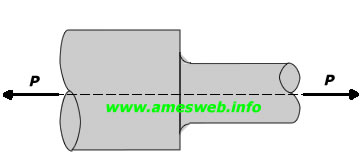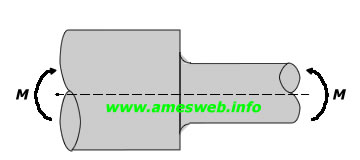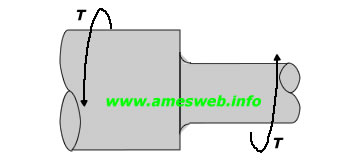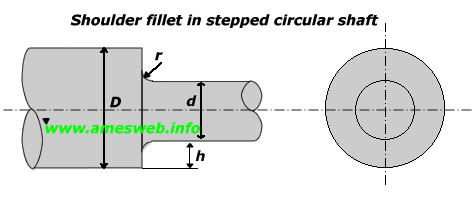Shoulder fillet in a stepped
circular shaft. Stress concentration factors (Kt) for tension, bending and
torsion loads.
Note: Use dot "." as decimal separator.
|
RESULTS |
|
LOADING TYPE - TENSION |

|
|
Parameter |
Value |
|
Stress concentration factor [Kt]
* |
---
|
--- |
|
Nominal tension stress at shaft [σnom ] o |
---
|
|
|
Maximum tension stress due to tension load [σmax ] |
---
|
|
LOADING TYPE - BENDING |

|
|
Parameter |
Value |
|
Stress concentration factor [Kt]
* |
---
|
--- |
|
Nominal tension stress at shaft [σnom ] + |
---
|
|
|
Maximum tension stress due to bending [σmax ] |
---
|
|
LOADING TYPE - TORSION |

|
|
Parameter |
Value |
|
Stress concentration factor [Kt]
** |
---
|
--- |
|
Nominal shear stress at shaft [τnom ] x |
---
|
|
|
Maximum shear stress due to torsion [τmax ] |
---
|

|
|
Tension |

|
|
$$0.1\le h/r\le 2.0$$ |
$$2.0\le h/r\le 20.0$$ |
|
$${ C }_{ 1 }=0.926+1.157\sqrt { h/r } -0.099h/r$$ |
$${ C }_{ 1 }=1.200+0.860\sqrt { h/r } -0.022h/r$$ |
|
$${ C }_{ 2 }=0.012-3.036\sqrt { h/r } +0.961h/r$$ |
$${ C }_{ 2 }=-1.805-0.346\sqrt { h/r } -0.038h/r$$ |
|
$${ C }_{ 3 }=-0.302+3.977\sqrt { h/r } -1.744h/r$$ |
$${ C }_{ 3 }=2.198-0.486\sqrt { h/r } +0.165h/r$$ |
|
$${ C }_{ 4 }=0.365-2.098\sqrt { h/r } +0.878h/r$$ |
$${ C }_{ 4 }=-0.593-0.028\sqrt { h/r } -0.106h/r$$ |
|
$${ K }_{ t }={ C }_{ 1 }+{ C }_{ 2 }(2h/D)+{ { C }_{ 3 }(2h/D) }^{ 2 }+{ { C
}_{ 4 }(2h/D) }^{ 3 }$$ |
|
$${ \sigma }_{ nom }={ 4P }/{ \pi { d }^{ 2 } }$$ |
|
$${ \sigma }_{ max }={ K }_{ t }{ \sigma }_{ nom }$$ |
|
Bending |

|
|
$$0.1\le h/r\le 2.0$$ |
$$2.0\le h/r\le 20.0$$ |
|
$${ C }_{ 1 }=0.947+1.206\sqrt { h/r } -0.131h/r$$ |
$${ C }_{ 1 }=1.232+0.832\sqrt { h/r } -0.008h/r$$ |
|
$${ C }_{ 2 }=0.022-3.405\sqrt { h/r } +0.915h/r$$ |
$${ C }_{ 2 }=-3.813+0.968\sqrt { h/r } -0.260h/r$$ |
|
$${ C }_{ 3 }=0.869+1.777\sqrt { h/r } -0.555h/r$$ |
$${ C }_{ 3 }=7.423-4.868\sqrt { h/r } +0.869h/r$$ |
|
$${ C }_{ 4 }=-0.810+0.422\sqrt { h/r } -0.260h/r$$ |
$${ C }_{ 4 }=-3.839+3.070\sqrt { h/r } -0.600h/r$$ |
|
$${ K }_{ t }={ C }_{ 1 }+{ C }_{ 2 }(2h/D)+{ { C }_{ 3 }(2h/D) }^{ 2 }+{ { C
}_{ 4 }(2h/D) }^{ 3 }$$ |
|
$${ \sigma }_{ nom }={ 32M }/{ \pi { d }^{ 3 } }$$ |
|
$${ \sigma }_{ max }={ K }_{ t }{ \sigma }_{ nom }$$ |
|
Torsion |

|
|
$$0.25\le h/r\le 4.0$$ |
|
$${ C }_{ 1 }=0.905+0.783\sqrt { h/r } -0.075h/r$$ |
|
$${ C }_{ 2 }=-0.437-1.969\sqrt { h/r } +0.553h/r$$ |
|
$${ C }_{ 3 }=1.557+1.073\sqrt { h/r } -0.578h/r$$ |
|
$${ C }_{ 4 }=-1.061+0.171\sqrt { h/r } +0.086h/r$$ |
|
$${ K }_{ t }={ C }_{ 1 }+{ C }_{ 2 }(2h/D)+{ { C }_{ 3 }(2h/D) }^{ 2 }+{ { C
}_{ 4 }(2h/D) }^{ 3 }$$ |
|
$${ \tau }_{ nom }={ 16T }/{ \pi { d }^{ 3 } }$$ |
|
$${ \tau }_{ max }={ K }_{ t }{ \tau }_{ nom }$$ |